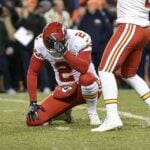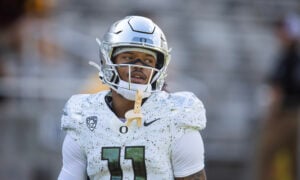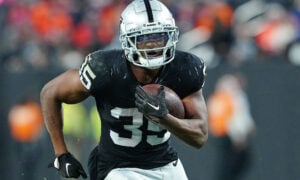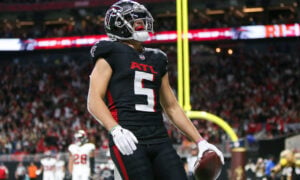Devy Profile: Bryce Love, RB Stanford
Position: Running Back
School: Stanford
Year: Junior
Birthday: 7/8/97 (20.3 years old)
Listed height: 5’10”
Listed weight: 196
If you’ve been in tune with college football at all this season, you’ve heard plenty of Bryce Love’s name… but there’s a good chance you hadn’t heard of him until this season. That’s fair; he spent the last two seasons as a backup for one of the best college (and, overall) running backs in recent history. I, myself, knew him as “that fast guy behind Christian McCaffrey” heading into 2017.
[am4show have=’g1;’ guest_error=’sub_message’ user_error=’sub_message’ ]
With the now-Carolina Panther out of the picture, though, Love has made up for lost time–and then some. He’s stolen the limelight for Stanford in each game of his junior year and shows no signs of slowing down. The North Carolina native has shown up and dominated at a devastating-yet-consistent level, both setting an NCAA single-game record and managing to rush for over 147 yards in all seven of his games.
It’s easiest to point to those eye-popping numbers to explain why Love is on everyone’s minds, but he also has the game to back those stats up. While he probably isn’t the best back in football, as his per-carry numbers would indicate (let alone by such a comical margin) he is a bona-fide NFL talent. The question is now of just how great a talent he is and will be as a pro.
As a Recruit
Love entered Stanford as a fairly well-touted prospect, touting a .9076 (4-star) 247sports composite rating. That measure placed him at 233rd among the entire 2015 class and as the sixth-highest “all-purpose” back. At The Opening in 2014, he finished 11th in combined SPARQ testing.
Production
As a freshman, Love was nearly as much of a receiver as a runner. As the fourth-string back, he got just 29 carries over the entire season, but did manage 15 receptions on 16 targets. His 16.1 yards per catch served as an early indicator for his explosive potential, which he’s gotten to put on a much fuller display with an augmented workload.
After Remound Wright and Barry Sanders, Jr. graduated, Love became McCaffrey’s backup in 2016 and took full advantage. In an offense as run-heavy as Stanford’s, Love saw 111 carries despite backing up a 254-carry rusher. With that opportunity to spell the top-ten pick, Love ran for over seven yards per carry as defenses were caught sleeping with McCaffrey away from the ball.
Perhaps a regression was due for that per-carry mark in 2017 as Stanford lost its transcendent talent and Love became the number one rusher. Somehow, his numbers, instead, have exploded. The seven-game stat line of 135 attempts, 1387 yards, and 11 touchdowns is incredible no matter how you slice it. An efficiency measure of 10.5 yards per carry is insane. So is well-over 1000 yards in half of a regular season. His 15.1 highlight yards per opportunity (in brief: explosiveness) is similarly unbelievable.
It’s also impossible to knock those numbers. Big numbers against bad competition? Sure, but those numbers aren’t big, they’re astronomical:
| Opponent (defensive rank) | Attempts | Yards | Y/A |
|---|---|---|---|
| Rice (124) | 13 | 180 | 13.8 |
| UCLA (115) | 30 | 263 | 8.8 |
| Arizona State (107) | 25 | 301 | 12.0 |
| Oregon (60) | 17 | 147 | 8.6 |
Oh yeah, and when he’s playing good defenses, he does alright too:
| Opponent (defensive rank) | Attempts | Yards | Y/A |
|---|---|---|---|
| USC (31) | 17 | 160 | 9.4 |
| San Diego State (45) | 13 | 184 | 14.2 |
| Utah (37) | 20 | 152 | 7.6 |
Maybe one would suggest he’s only taking what his forceful offensive line allows him, but that’s not the case either–at least from two of those six games: In the two games of his that I tracked (against USC and UCLA), Love generated 268 rushing yards, well over half of those incredible numbers.In his worst 2017 performance, October 7th when the Utah Utes put him in shackles, Bryce Love ran for 7.6 yards per carry (better than six of otherworldly Saquon Barkley’s seven 2017 games, for reference).
Of course, over ten yards per carry is almost certainly unsustainable. Still, to put it simply, Bryce Love has played the primary role in unprecedented rushing efficiency and production. It takes a good player to do that.
Career rushing and receiving totals (to date)
Rushing
| Year | Attempts | Yards | Y/A | TD |
|---|---|---|---|---|
| 2015 | 29 | 225 | 7.8 | 2 |
| 2016 | 111 | 783 | 7.1 | 3 |
| 2017 | 135 | 1387 | 10.3 | 11 |
| Total | 275 | 2395 | 8.7 | 16 |
Receiving
| Year | Receptions | Yards | Y/R | TD |
|---|---|---|---|---|
| 2015 | 15 | 250 | 16.7 | 1 |
| 2016 | 8 | 83 | 10.4 | 1 |
| 2017 | 4 | 19 | 4.8 | 0 |
| Total | 27 | 352 | 13.0 | 2 |
On the Field
As a runner, everything begins and ends with speed for Bryce Love. Putting quickness, agility, acceleration, and long speed all in one equation, he is perhaps the most consistently fast running back in college football.
He has proved to move exceptionally in tight spaces both quantitatively (he hit 23 of the 24 holes he found in my tracking) and qualitatively. His footwork is as clean and controlled as you could ask. He shows flashes of McCaffrey when changing direction. Lateral quickness makes him one of the best in the business at avoiding defenders in the backfield:
this is an incredible run… most guys get stopped in the backfield, but he makes it look routine, then skrt pic.twitter.com/e7SDxCTgui
— Stephen Gill (@stephengill_ts) October 4, 2017
The benefits of his agility spill over into his elusive maneuvers, too. All over his tape, you can observe defenders tackling ghosts. This is no coincidence; that agility has allowed him to perfect the subtle sidestep. The results are a beautiful display of tacklers missing by a foot in one direction or another as Love churns on, undisturbed.
Of course, he can also turn on the jets in the open field. There’s no catching up to him once he’s hit his top gear, but perhaps what’s more deadly is how well he plants his feet and accelerates. With just a hint of daylight, he explodes through holes, turning five-yard gains into 20-yard chunks, and sometimes much more.
Obviously, that’s a tremendous collection of attributes to work with. But his skill set doesn’t end there. Accompanying his consistently-great speed is a fully-developed mental game. His vision checks all the boxes: He constantly makes the right decisions (he identified 24 of 25 possible holes in my tracking), he reads the field quickly and effectively, he finds daylight at the second level, he successfully adjusts to tacklers on the fly, and he can anticipate gaps that have yet to open up.
His running style, meanwhile, is a terrific fit with his strengths and weaknesses. He fully understands his speed and its (relative) limitations, correctly judging when to bounce his runs and when to get upfield. He’s among the class’s best at using space to his advantage, maximizing the space-versus-downfield speed tradeoff, similar to how Saquon Barkley kills defenses that give him breathing room. Patience for developing holes allows Love to maximize what his blocking provides to a further extent.
Most important, though, is how he atones for a considerable disadvantage in size and strength. At just 5’10” and under 200 pounds, Love is liable to fall at first contact without much resistance. At times, arm tackling has also proved to be a problem. On the positive side, he’s done well to address these issues.
Perhaps he’s taken notes from McCaffrey–ten months ago, I wrote about how a well-molded running style made inside rushing viable for such a small back. Love makes use of the same methods, primarily undying feet and perfect pad level. There’s no quit to his game, which results in a surprising amount of yards after contact for such a small back. Low shoulders, meanwhile, allow him to leverage what little power he does have in his legs to generate tough extra yardage--an inconspicuous, yet essential element of rushing production.
Still, savvy can’t make up for all the flaws in someone’s game… and his savvy hasn’t touched his pass blocking. Off the top of my head, I can’t think of a single player from the 2016 draft class who pass blocked as consistently poorly as Love. Failures stemming from strength disadvantages are predictable and widespread. What’s worse is that his mental acumen hasn’t caught up to the pass blocking department. At some points, he’s been lackadaisical and plain soft (unexpected, given his running tenacity). Something is (or, many things are) up. He gets ran around, jumped through, or plain steamrolled from play to play in pass protection.
Conclusion
Compared to other prospects in the middle of their seasons, it’s pretty easy to nail down what Bryce Love is good at and just how good he is at those strengths. The trouble comes when putting those attributes together and projecting his future in the NFL. If he were coming out just a few years before now, it’d be easy to rule him out, as simply too small to be a big part of any offense. But the last year or so has ushered in a load of smaller running back talent, in the likes of the two Stanford backs, Ronald Jones, Akrum Wadley, Tarik Cohen, and many more. So, perhaps the NFL is now ready to take on smaller backs? (In short: We don’t know yet, but the signs are promising.)
If small backs can produce in the NFL, we must now figure out what specifically Love does and does not do. As things stand for the Stanford man, he’s ready to run the ball in an NFL backfield. He obviously has plenty of physical tools as well as the requisite vision to find holes in NFL trenches. Combining that with a fine-tuned style will allow him to run between the tackles without bleeding yards due to his diminutive stature too.
With decent rushing volume, Love should thrive. The aforementioned vision combined with his agility and quickness (which will both be still well above-average by NFL standards) will make him a consistent runner down to down. When he sees daylight, he’ll chew up yards just as he’s been doing at Stanford. Top-notch acceleration and long speed are a recipe for production success on their own, and by adding his elusiveness to the equation, Love could become one of the NFL’s better yard generators. He’ll always be limited by his size, but I’ve seen enough from him to suggest that that weakness won’t cripple him. On the other hand, he will need to seriously develop his pass blocking in order to see any noticeable work in the passing game.
Putting all these factors together, you have to hedge on a decent amount of uncertainty with Love–which also goes for just about any prospect. We don’t know how much he’ll improve his pass blocking, and similar to everyone else in the non-Barkley god tier, landing spot will play a huge part in deciding his dynasty value. As things stand now, he falls into my giant third-tier cluster of prospects. That puts him at 16th in my rankings at the moment, a spot that gives him credit and value for all that he offers in the running game but factors in pass blocking uncertainty. Note that because of the size of the tier (which spans from him all the way up to Damien Harris), Love could shoot into my top ten without much work.
To sum up this long-winded, in-season profile: Bryce Love’s insane production is legit, and although he’s not necessarily the best running back prospect, he can post big numbers in the NFL the same way he has done so at Stanford. At the same time, there are holes (one, in particular) to his game that can hold him back from success at the next level.
[/am4show]
- 2024 Rookie Drafts: Running Back Tiers Primer - May 10, 2024
- Dynasty Fantasy Football: Surprise Undrafted Players in the 2024 Class - May 2, 2024
- 2024 Dynasty Fantasy Football Rookie Drafts: A View from the 1.03 - April 21, 2024


































































